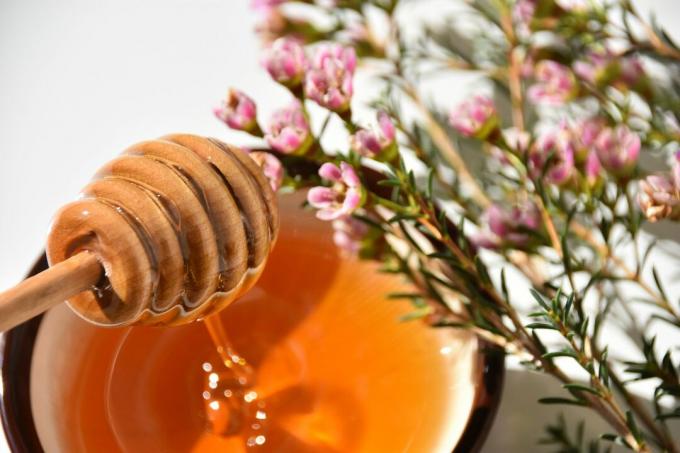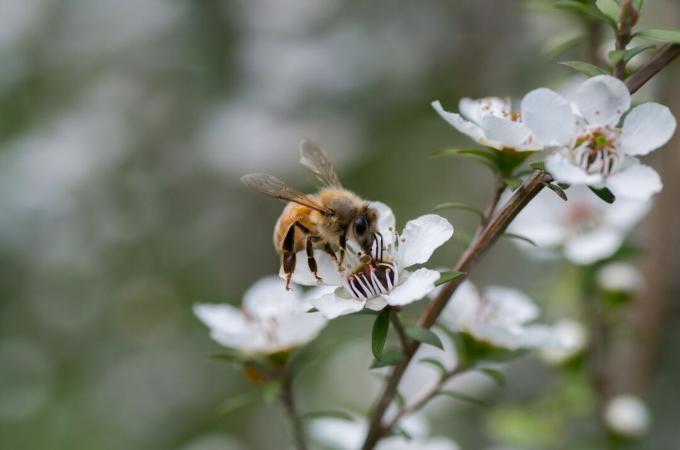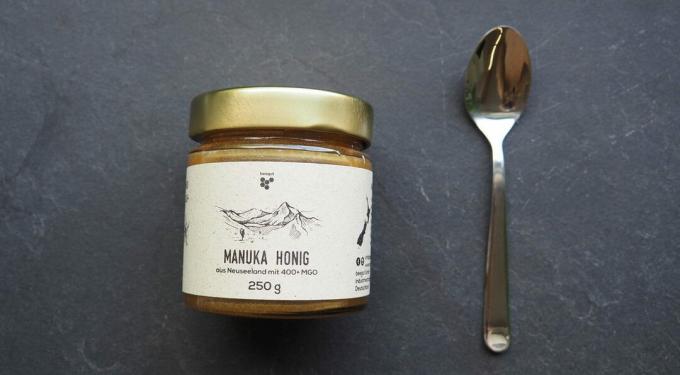Bees from New Zealand produce what is probably the most expensive and valuable honey in the world. We show what the miracle honey Manuka is all about.

Honey has been used medicinally for thousands of years. The so-called Manuka honey from New Zealand is said to have a very special effect. In the following we show what effect Manuka honey has and how best to use it and present a recommended source of supply.
contents
- Manuka honey
- The Effects of Manuka Honey
- Buy Manuka honey
Manuka honey
Honey is still used in a wide variety of natural medicines today. A special type of honey that stands out in this regard is Manuka honey. Its miraculous effects were first discovered in New Zealand in 1998. But what exactly makes this honey so special?
Manuka honey comes from the flower nectar of the New Zealand Manuka bush (Leptospermum scoparium), a relative of the Australian tea tree. Manuka is also called South Sea myrtle or New Zealand myrtle and is only found in New Zealand and the south-eastern region of Australia. This plant grows in the form of a shrub or tree and can grow up to four meters in height. Their white or pink flowers often bloom for months. The real Manuka honey is obtained by placing bee colonies close to Manuka bushes. Honey farmers in New Zealand even use helicopters to locate the wild bushes and then set their beehives near them.

The particularly resilient Manuka bush can survive on cleared areas. Exactly this property is welcome and is used for reforestation of lost vegetation. After just 50-75 years, a Manuka bush can regenerate the soil to such an extent that other trees can also grow again. Since Manuka does not taste good to cows, sheep or other animals, they benefit not only from reforestation projects bees and with them the beekeepers. With the purchase of Manuka honey you are not only doing something good for yourself, you are also often supporting the renaturation of New Zealand.
The Effects of Manuka Honey
The special Manuka honey not only has an antiseptic and wound-healing effect, but also has an antioxidant effect. It also has positive effects on bacteria and fungi and can even cure viral diseases. It is also helpful in diseases of the gastrointestinal tract. A perhaps initially surprising application of Manuka honey is in the mouth: The viscous gold also helps against infections and even tooth decay bacteria thanks to its ingredients. Manuka honey can also be used against warts, acne, herpes and scars.
These different areas of application of honey have a special reason - the ingredient methylglyoxal is much stronger in this type of honey than in other types of honey. This substance enhances the healing properties of honey. For example, if you have a sore throat, a spoonful of honey is enough to remedy the situation. Of course you can also dissolve the Manuka honey in warm tea and then drink it.
notice: The honey should not be heated above 40 °C so that the valuable ingredients are preserved.
The antibacterial activity of Manuka honey is indicated with the help of the so-called MGO content. MGO stands for methylglyoxal and describes the main active ingredient in honey. Methylglyoxal occurs naturally in the nectar of the Manuka flowers before it is ingested by the bees. Interestingly, pure Manuka honey contains between 100-800 mg per kilogram of methylglyoxal, while other honey has a maximum of 20 mg. If you want to buy Manuka honey, you should definitely pay attention to the ingredients. High-quality Manuka honey has at least an MGO content of 400.
How does manuka honey work?
- Manuka honey has an antiseptic, wound-healing and antioxidant effect
- The honey can be used against a wide variety of ailments, from diseases of the margin-intestinal tract to caries, acne and viral diseases
- The ingredient methylglyoxal enhances the healing effect of honey and is measured with the so-called MGO content
- A high-quality Manuka honey has at least an MGO content of 400
Buy Manuka honey
Manuka honey is not mass-produced and therefore has its price. A quarter kilogram of honey can cost up to 80 euros. The higher the MGO content, the more expensive it becomes. The high demand is also fatal for the sweet gold from New Zealand, because apparently the high honey prices also result in mass fraud with Manuka honey. A few years ago it was noticed that more Manuka honey is traded on the world market than the New Zealand bees could have produced it. Around 10,000 tons of "Manuka honey" are sold worldwide, although New Zealand can only report production of 1,700 tons.

One way of quality assurance is to test the MGO content in the laboratory. For example, beegut's Manuka honey is examined in German laboratories to rule out counterfeiting. The high-quality Manuka has an MGO content of 400+ and convinces with its plastic-free packaging. You can find more information about Manuka honey from beegut here.
...and receive concentrated plant knowledge and inspiration directly in your e-mail inbox every Sunday!
